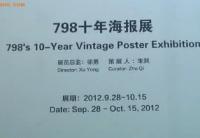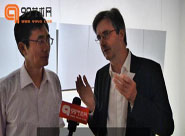我们知道,如果抛开官方的教科书式的历史说教,中国文明的历史是一个碎片化的过程,特别是近代以来,中国文化的历史因为政治的原因而出现了很多次人为的断裂。出生于上个世纪六十年代末的肖红在他自身的成长过程中,也应该是能够对于这种碎片式的文化历史感同身受。这样,这种断裂的文明碎片就成为了一种外在于生命主体的物化的“它们”。在这种文化历史观的逻辑中,人物主体空洞、茫然的眼神就成为了与之相对照的另一个参照系,更隐喻了一种文化历史的宿命感。
As we know that if we discard the historic preaching in official textbook, Chinese culture is a procedure of fragment, especially in the modern history, there are many factitious fragmentations in history of Chinese culture as a result of politics. Xiao Hong, who was born at the end of the 1960s, should be deeply affected by this fragmental culture and history during his own growth. In this way, these disintegrated cultural segments turn into a materialized “Non-Life They” out of life noumenon. In this cultural historism logic, the vacuous and vacant eyes of character become another frame of reference reflecting it, which furthermore insinuate a cultural and historical foreordination.
随着历史文化价值观的变化而变化的是画面形式和技法语言的调整。在这些近作中,人物的头部形象被处理成了更像一个透明的容器,以强化它的物质化的特征;而那些贴片式历史文化碎片也并没有简单地平涂在人物的面部体积上,而是处理成了一种似乎具备了液体的特征。这样,人便成为了一种文化的容器和载体,具体的“人”无法超越于自己的文化历史宿命。至此,肖红在早期的创作中所流露出来的壁画式的历史时空意识,也从一种平面的并置发展成为了多时空的交融。这样,他的油画技法语言便也从早期的更加注重材料物性特征的写意式涂抹,变成了注重多空间融合的渲染。这个时候,我们也可以发现,他早年在鲁迅美术学院参加法国画家克劳德·依维尔油画研修班的经历,只不过,在他最近的创作中,克劳德·依维尔对于物体的写实性的细节描绘的技法被他创造性地与以敦煌壁画为代表的中国传统壁画的表达方式结合在一起了。这样,我们在肖红的作品中便能看到线、面与体积的结合,写实与写意的结合,真实与虚拟的结合,细腻与粗犷的结合,这些,是肖红对于油画绘画语言的创造性发挥。
2010年4月4日 于北京通州
What revolutionized with the changes of historical and cultural value is the adjustment of painting form and techniques usage. In the recent works, image of characters’ head is treated as like a transparent container, to emphasis its materialized characteristics. Those chipped historical and cultural fragment are not simply painted on the character’s facial volume, but was treated as if they have liquid feature. By this means, people turn out to be a container and carrier for culture. Concrete “People” can not surpass their own cultural and historical destiny. Up till then, Xiao Hong’s historical time-space conscious with mural style expressed in his early creation, has developed from a plane layout to the merge of multi space-time. In that way, his painting techniques matured from freehand brushwork in the previous stage which emphasizes more on material properties, to highlighting glamorization of multi spaces blend. At this point, we can figure out his previous learning experience in French painter "Claude Yeevier" Oil Painting Class in Lu Xun Art Institute. Only that in his recent creation, Claude Yeevier’s techniques of painting realistic details is creatively combined with Chinese traditional mural expression represented by Dunhuang fresco. So we can see the combination of line, plane and volume, realism and impressionism, reality and imagination, delicateness and ruggedness in Xiao Hong’s works. These are Xiao Hong’s creative usage of painting language.
Apr 4, 2010, in Tongzhou District, Beijing

